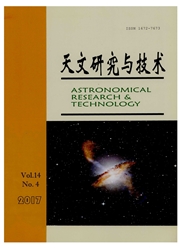

 中文摘要:
中文摘要:
提出了一种新型太阳光谱望远镜的建议,这种望远镜能够同时记录太阳日面观测区域的两维空间的色散(三维光谱),即一系列同步狭窄带通的光谱图像。借助该望远镜我们可以得到高时间分辨率的光谱图(10ms),进而能够做细致的光谱分析。该望远镜由一组子望远镜组成,每个子镜负责记录观测区域的一个事先设计好的透过带,所有透过带覆盖了所研究谱线的整个光谱波段,可以用来诊断不透明的低层大气物质流的三维速度场、重构太阳活动区(即太阳耀斑区)的三维结构。此外,若每个子镜都加栽上偏振仪时,则能够得到精确的矢量磁场,这种矢量磁场能够作为第二代视频磁场测量仪。此望远镜由一组紧密排列的子镜组成,文章分别给出了两种不同排列子镜的方式。描述了用来观测的每个子镜的透过带的样品光学表,并且提出了不同探测器的同时成像技术。最后,我们把该望远镜和ATST(Advanced Technology Solar Telescope)进行了比较。
 英文摘要:
英文摘要:
The concept of a new type of the solar optical telescope is proposed that can record simultaneously the two dimensional dispersions (3D spectrum) of observed regions on the solar disk, i. e. a series of synchronous narrow-bandpass spectral images. It can allow us to do detailed spectral analysis while being able to own a super high temporal resolution, say, tens of milliseconds. Such a telescope can be formed with an array of sub-telescopes in each of which an image of the observed area is recorded at the different designed bandpass within one interested line, and the collection of these bandpasses spreads and covers the whole spectral band of an interesting spectral line. It can be suitable to diagnose the thrce-csanponent velocity fields of mass flows, and obtain the ability to reconstruct three dimensional (3D) structure of solar active region (say, solar flaring region) in the opaque lower atmosphere. And further, with the polarimeter mounted to each of its sub-telescope, the accurate measurement of the vector magnetic field can be realized, and it can be regarded as the second generation video magnetograph. One such telescope consists of many compact subtelescopes. Two kinds of configurations of compact arrays mounting the sub-telescopes are outlined respectively. A sample optical scheme realizing the narrow band-pass (up to 30m A ) observation for each sub-telescope is described and the crucial technology keeping the cadence of simultaneous imaging is presented in the text. Generally, the aperture and number of the sub-telescopes depend on the property of measurement. For instance, the flare observation needs more sub-telescopes with smaller aperture than that of the vector magnetic field measurement. The advantage of constructing such a telescope lies in that each sub-telescope can be constructed as an etalon. Finally comparison with ATST (Advanced Technology Solar Telescope) is stated.
 同期刊论文项目
同期刊论文项目
 同项目期刊论文
同项目期刊论文
 期刊信息
期刊信息
